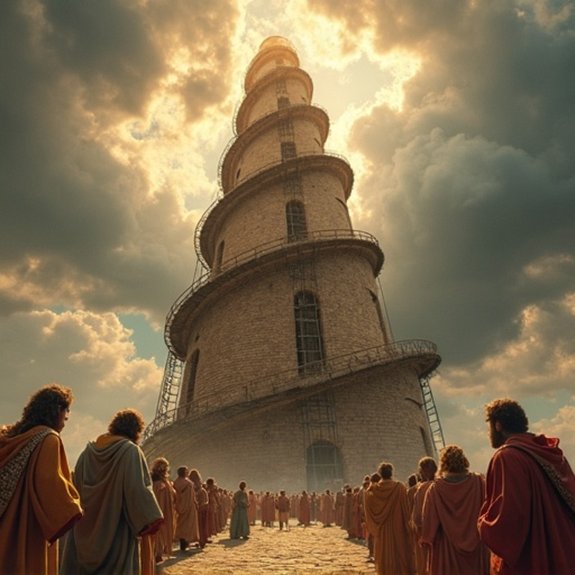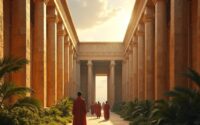The Tower of Babel: Myth Vs Reality
The Tower of Babel‘s story has captivated scholars for centuries, but recent archaeological discoveries in ancient Babylon blur the lines between legend and historical fact. Excavations have revealed massive ziggurat foundations that match biblical descriptions with startling accuracy. While linguists debate whether a single catastrophic event truly scattered human languages, the ruins of Etemenanki suggest something extraordinary did happen in Mesopotamia that forever changed how humanity understood itself.
Introduction

When ancient scribes first recorded the Tower of Babel story in Genesis 11, they crafted one of humanity’s most enduring tales about language, ambition, and divine intervention. The narrative describes humanity’s attempt to build a tower reaching heaven, prompting God to confuse their single language into many, scattering people across the earth. This account has shaped religious thought, inspired countless artworks, and influenced linguistic theories for millennia.
Modern archaeology and historical research now offer fresh perspectives on this biblical tale. Scholars’ve identified potential real-world inspirations, including Mesopotamian ziggurats and the ancient city of Babylon itself. The story’s themes resonate beyond religious contexts, addressing universal questions about human cooperation, communication barriers, and the limits of collective ambition. Understanding both mythical and historical dimensions reveals deeper truths about ancient civilizations.
Ancient Mesopotamian Archaeological Evidence
Excavations across Mesopotamia have unearthed massive ziggurat foundations that match biblical descriptions of the Tower of Babel. The Etemenanki ziggurat in Babylon, dedicated to Marduk, stood approximately 91 meters tall before its destruction. Archaeologists’ve discovered its base measured 91 by 91 meters, confirming ancient texts’ dimensions.
Cuneiform tablets from the sixth century BCE describe Nebuchadnezzar II’s restoration of this “House of the Foundation of Heaven and Earth.” The Schøyen Collection contains a stele depicting the tower’s seven tiers alongside Nebuchadnezzar himself. Additional evidence includes fired brick remains bearing royal inscriptions and bitumen mortar matching Genesis’s account.
Similar structures exist throughout the region—Ur’s ziggurat, Eridu’s temple platform, and Borsippa’s Tongue Tower. These monuments demonstrate Mesopotamians’ architectural ambitions and their desire to connect earth with heaven through monumental construction.
Notable Cases or Sightings

Throughout history, travelers and scholars have reported encountering ruins they believed to be the biblical Tower of Babel. In the 12th century, Rabbi Benjamin of Tudela identified the Birs Nimrud ziggurat near Babylon as the tower’s remains. He described a structure split by divine lightning, matching biblical accounts.
Giovanni Villani’s 14th-century chronicle claimed the tower stood 4,000 paces high before God’s intervention. European explorers in the 1600s frequently mistook various Mesopotamian ruins for Babel, particularly the massive ziggurat at Borsippa.
Robert Ker Porter’s 1818 expedition produced detailed sketches of what he insisted was Babel’s foundation. However, archaeologists later identified his discovery as Etemenanki’s base in Babylon. These misidentifications reveal how desperately observers wanted to validate the biblical narrative through physical evidence.
Common Theories or Explanations
While ancient misidentifications sparked centuries of speculation, modern scholars have developed several compelling theories about the Tower of Babel’s origins. Many historians believe the story’s based on Babylon’s massive ziggurat, Etemenanki, which stood 91 meters tall before Alexander the Great discovered it in ruins. Linguists propose the narrative explains humanity’s linguistic diversity through allegory, addressing why neighboring peoples couldn’t understand each other’s languages.
Archaeological evidence suggests the tale might’ve emerged during the Babylonian exile when Jewish captives encountered Mesopotamian architecture. Some researchers argue it’s political commentary criticizing imperial hubris and forced labor practices. Others see parallels with flood myths—both stories reset humanity after moral failure. The account’s placement in Genesis, they note, serves as a bridge between primordial history and Abraham’s narrative, establishing why God chose one nation from many scattered peoples.
Frequently Asked Questions
How Has the Tower of Babel Story Influenced Modern Architecture and Skyscrapers?
The Tower of Babel story’s influenced modern architecture through humanity’s drive to build ever-taller skyscrapers. Architects’ve embraced the myth’s symbolism of ambition, creating structures that reach skyward while incorporating multicultural design elements celebrating human diversity.
What Moral or Spiritual Lessons Do Different Religions Draw From This Narrative?
Different religions interpret Babel’s narrative as warning against human pride and overreach. Judaism emphasizes unity’s importance, Christianity sees divine sovereignty over human ambition, while Islam teaches that diversity in languages and cultures reflects God’s wisdom.
How Is the Tower of Babel Depicted in Art Throughout History?
Artists’ve depicted the Tower of Babel as a massive spiraling structure reaching skyward, often showing construction chaos and divine intervention. Bruegel’s famous painting shows architectural detail while medieval manuscripts emphasize humanity’s hubris through dramatic scenes.
Which Modern Languages Trace Their Etymology to the Babel Story?
The word “babble” in English directly derives from the Babel story, meaning confused speech. Similar etymological connections exist in French (“babiller”), Italian (“balbettare”), and other European languages, where terms for confused or unintelligible speech reference Babel’s linguistic confusion.
What Are the Main Differences Between Biblical and Babylonian Tower Narratives?
The biblical account emphasizes humanity’s prideful rebellion against God who confuses their language, while Babylonian narratives like Enuma Elish focus on ziggurat construction honoring gods. Biblical version’s punitive, Babylonian’s celebratory of architectural achievements.


